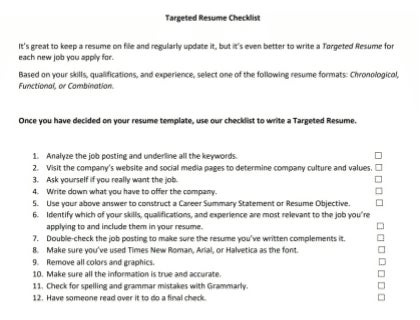Turn any Resume into a Targeted Resume.
Based on your skills, experience, and qualifications, you can choose one of the three main resume formats and turn it into a targeted resume. Choose between the chronological resume, the functional resume, or the combination resume. Our 'How to Write a Resume' article will help you decide which one is the best fit.

Checklist for Writing a Targeted Resume
Download a checklist of steps to follow when writing your targeted resume.
Download NowHow to Write a Targeted Resume:

Follow the steps below to create a resume that is sure to attract the attention of potential employers.
Structure your resume accordingly.
Analyze the job posting and highlight all the keywords.

Read through the job posting carefully to make sure you have the qualifications, experience, and personality traits required for the position. Note important keywords and underline them.
Review the website and social media pages of the organization you're interested in.

Visit the website and social media pages of the company or institution you're interested in, and make sure that your ideology aligns with theirs. If you're not a good fit for the position, it will come through in the resume as well as your correspondence with the hiring manager.
It takes a lot of effort to write a Targeted Resume, so make sure you really want the position before you begin.
Choose a resume format.

You'll need to have chosen a resume format before you create your Targeted Resume. Remember to read through our How to Write a Resume Article as it contains step-by-step guidelines and tips on how to construct each section.
Identify which of your skills, qualifications, and experience are most relevant to the job you’re applying to.

Careful planning must be done before you write your targeted resume, and only the skills, experience, and qualifications relevant to the job at hand should be included.
Pay special attention to how you brand yourself in a targeted resume. Be honest with yourself and your prospective employer when you draw up a Targeted Resume, and don't embellish.
Think about your personal value proposition.
Write down what you have to offer your prospective employer.

Once you have done your research on the company or institution, and gained a good grasp of the work culture, ask yourself, "What can I offer them?"
Once you have the answer, write it down. You'll want to use this answer when you construct your Career Summary Statement or Resume Summary.
Review your existing resume.

Read through your existing resume. (If you don't have a resume on file yet, make rough notes for all the sections using your chosen template as a guideline.) Select only the skills, experience, and qualifications most relevant to the job you are applying for. Next, double-check the job posting to make sure your resume complements it.
Write out your resume.
Choose the right font.

Choose a simple font like Times New Roman, Arial, or Helvetica. Use black text and font size 10–12. You may bold the headings. Do not use color or graphics and be mindful to remove them if you are using a resume builder.
Review your list of keywords.

Go back to your list of underlined keywords identified in the first step above. Where applicable, carefully insert the keywords into your resume. These keywords will help optimize your resume for an Applicant Tracking System (ATS), but make sure your resume reads well after you've added the keywords.
Be honest.

Do not include false information on your resume or try to hide gaps of unemployment. Your prospective employer may very well uncover anything you're trying to hide during a reference check.
Edit your resume accordingly.

Use Grammarly to pick up mistakes and also get someone else to read over your final resume before you submit it.
Additional Resources:
Need to write a CV but don't have Microsoft Word? See our article on creating a top-class resume template using Google Docs.

